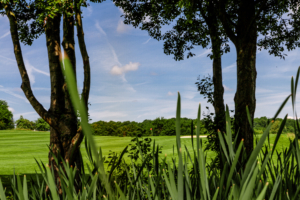GC Taunus Weilrod: Together for more environmental protection
This is about more than just golf – that’s important to Irmina Bültmann, vice president of the Taunus Weilrod Golf Club, when she talks about the 18-hole facility in Hochtaunus. The experience of nature plays an essential role on this golf course, balancing the demands of the sport with the requirements of fauna & flora. Anyone who looks at the hilly landscape, now well ingrown, knows why.
Cooperation with beekeeper
Living spaces have developed in many areas on the classic club site over more than 40 years. Lush hedge structures provide nesting habitat for numerous birds and insects. Hidden behind a part of it are also the bee boxes, which have long been installed here. The cooperation with a beekeeper is as successful as that with the master fisherman, who takes care of the water areas on the site and the fish stocking. Its positive report clearly shows that fertilizers are used sparingly here and that pesticides and herbicides are avoided as much as possible.
The Weilrod Golf Club is one of those golf courses that still operates according to the classic community principle. A community of enthusiastic golfers lends a hand when the need arises. This also applies to the area of greenkeeping, where the volunteer board repeatedly struggled with staff shortages last year. “We then also launched a call for cooperation at one point, which is not a problem for us,” explains Irmina Bültmann.
Participation in habitat golf course
Basically, the motto here is to enable a good gaming experience with as few interventions as possible anyway. The landscape itself, with its often towering trees, well-moved terrain and views of the open countryside, offers plenty of charms. The club, which also participates in the “Golf Course Habitat” project of the Hessian Golf Association, wants to position itself further as a sustainable golf facility with nature-oriented activities.
In addition to the existing meadow orchard along runway 1, another is to be created on the site, which covers a total of 60 hectares. A Benjeshedge, which has already been successfully implemented once, is also to be implemented in another area. In addition, the successful work in creating flowering meadows will be continued. Along the fairways, tees and greens, which are hardly affected by play, small areas are taken out of mowing and transformed from classic rough into valuable meadows.
In Bültmann’s view, this is also an absolutely necessary measure with regard to water management. Like most golf courses in the Hessian Golf Association, Taunus Weilrod Golf Club suffered from last year’s drought. “We don’t have fairway sprinklers and, fortunately, we have a large 35,000-square-foot foil pond,” the vice president says, explaining the concept, which calls for low water use anyway. However, during the extremely dry months of summer 2022, it was also realized that even the storage pond might not provide enough water, if no rain comes. This is one of the reasons why we are now looking into how we can improve the filling of the reservoir by means of drainage and the collection of water on the roof of the clubhouse.
Saving energy and water as a long-term task
For a classic golf club, the challenges are great – especially when it comes to energy and costs, sums up Ulrich Bültmann, who as a member of the board not only takes care of irrigation issues, but now also supplies the facility with energy. In the entrance area of the clubhouse, one of the new water and energy saving projects has already been implemented: The classic flower bed has now given way to a perennial bed that requires no irrigation and still looks good. A small project, says Irmina Bültmann, but a typical example of how a golf course can be made more sustainable in many ways. As I said, the Taunus Weilrod Golf Club is about more than just golf.







 Foto: Husqvarna
Foto: Husqvarna